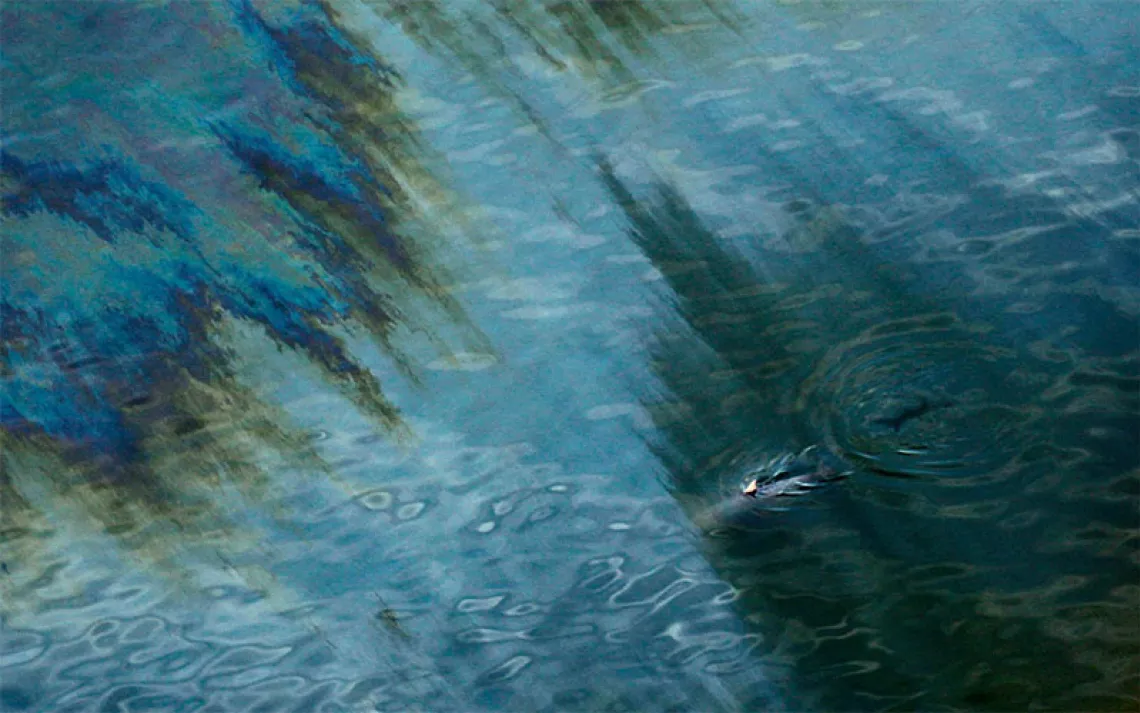Orchids Are Doing Something Totally Weird With Fungi
We’re learning how varied interspecies partnerships can be

Researcher Ida Hartvig holds the root of a Tipularia discolor orchid. | Photo by Christian Elliott
Eyes to the ground, molecular ecologist Melissa McCormick was scanning for plants as she walked the forest behind the Smithsonian Environmental Research Center lab, where she is a principal investigator. “Tipularia!” she cried, pointing to a small green leaf speckled with purple, one of a series of easy-to-miss plants forming a line on a rotting log.
The Tipularia discolor—a.k.a. cranefly orchid—she spotted is not the bright, showy sort you see in grocery stores or florists’ shops. It only sprouts on decomposing wood. One of nine species found on the Smithsonian’s coastal Maryland campus, in another few years it will send up delicate stalks covered with small, brownish maroon flowers. Like half of all North American orchids, the cranefly orchid is incredibly rare.
McCormick collected a soil sample containing fungi that the orchids feed on as they germinate and grow. Most terrestrial plants form relationships with fungi in the soil—they’re called mycorrhizal fungi for their role in a plant’s root system, or rhizosphere. Usually, the fungus attaches to the plant’s roots, where it offers nutrients, such as nitrogen, in exchange for sugars the plant produces through photosynthesis. They cooperate.
But orchids don’t have the typical, synergistic relationships that most plants have with fungi. They do something unique, as far as we know. Orchids eat their fungi alive.
“They basically parasitize their fungi,” McCormick said. A fungus grows in tight coils within the orchid’s plant cells; the flower uses a natural fungicide to control its spread, absorbing its nutrients over time. Orchid embryos, called protocorms, can live underground for years this way, snacking on fungi and waiting until conditions are right to emerge.
Why do fungi put up with the strange, parasitic relationship? “My thought is that it’s just the fungus foraging for food, and it happens to grow inside the orchid roots,” McCormick said. “It just spreads out, happens upon an orchid and gets eaten a little, but that’s not enough of a selective pressure for it to evolve different behavior.”
Orchidologists have known orchid seedlings rely on digesting fungi to survive since the early 1900s. It wasn't until the 1990s, however, that scientists started using DNA to understand the nature of that relationship. Systematic documentation of orchid fungi is just getting started.
Back in the lab, fungi from the new samples would join 1,200 other slime-filled test tubes in a cabinet comprising the largest orchid mycorrhizal fungi collection in the world. By studying orchids and their fungi together, McCormick and her fellow Smithsonian researchers are working to understand this unusual interspecies relationship better. Doing so, they hope, might help preserve a vast family of plants under threat.
How vast? There are more than 25,000 unique orchid species. That’s more than mammals, birds, and reptiles combined. Orchids represent 10 percent of all plant species on Earth. They come in a nearly endless variety of shapes and colors. Yet about half of orchid species worldwide are endangered or threatened due to habitat loss and climate change.
McCormick and her colleagues founded the Smithsonian's North American Orchid Conservation Center to collect seeds and fungi for all 210 North American orchid species, information that will enable future preservation efforts. The orchid lab currently has fungi from 85 orchid species in its collection. They hope to eventually teach botanical gardens and citizen scientists to grow native orchids more effectively.
If we want more orchids, we must support the fungi they depend on, but that’s easier said than done. Orchids are exacting about fungus choice, more particular than other plants. Most orchids have just one corresponding fungus they can consume. Some orchids even require different species of fungi at each life stage: one species to sprout, another to live underground as an embryo, and yet another to live as an adult plant.
When germinating, Tipularia orchids depend on a specific fungus from the Protomerulius genus; after growing its first leaves, the orchid can then can use a variety of fungi from the genus Tulasnella. Identifying those fungi without DNA sequencing is nearly impossible. Many such fungi look more or less the same.
“Think a smear of jelly on wood that may or may not become totally transparent when it’s dry,” McCormick said. “They’re pretty unimpressive looking as fungi go.” Even though a given teaspoon of soil contains, on average, over 150 species of fungi, scientists estimate that there are millions of fungus species on Earth. There’s no guarantee an orchid will find the one it needs.
“Identifying what all these fungi are is really important for orchid conservation,” McCormick said. “Even if you’ve got an orchid plant or you’ve got a bunch of seeds, you still can’t grow them if you don’t have the right fungus. If it’s not there, they’re not going to survive.”
And now, scientists are learning there are more than fungi wrapped up in orchid roots; a close look at the soil they grow in actually reveals a complex blend of fungi and bacteria. At the Smithsonian lab in Maryland, visiting researcher and orchidologist Ida Hartvig is working on sequencing all that DNA to discover the cocktail of organisms orchids need to thrive.
“We’re just beginning to learn that microorganisms, really the microbiome, has an outsized impact on plants,” Hartvig said. Often orchids can't survive without that microbiome. While the lab can germinate orchid seeds with fungi in petri dishes, most terrestrial orchids won’t grow to maturity in such conditions, or in sterile, bacteria-free soil.
“It seems like when fungi lose their own bacteria, they lose the ability to help the orchids germinate,” Hartvig said. “There is definitely more going on, and more and more levels of interaction.”
While orchids are the only plant known to parasitize fungi in this way, both Hartvig and McCormick said the unique discovery might say more about humans than plants. Humans love orchids. Victorians collected them obsessively. The delicate, finicky flowers have a certain mystique that captivates scientists and funding agencies alike. The charismatic orchid now commands millions of dollars in research funding, a disproportionate amount when compared to money apportioned to humbler-looking plant families.
“The truth is, there could be just as many interesting stories with less appealing plants,” Hartvig said. “Orchids—they’re pretty to look at so they get a lot of attention. There are other plant species which have these complex relationships and interesting evolutionary histories.”
We’re learning that the universe of plant-fungi interactions is vast. To discover what’s happening beneath the soil, however, first we have to look.
 The Magazine of The Sierra Club
The Magazine of The Sierra Club



